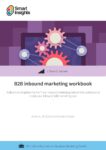B2C strategies can also be used for B2B audiences, after all, all marketing is human to human
B2B marketing strategies can be hard to get a handle on since reaching potential customers is very different from B2C ones, right?
Or are there strategies that translate from consumer-focused organizations to B2B ones?
In a word, yes...and it is those strategies that need to infiltrate our marketing efforts in the business-to-business world to compete in the current and future age. All marketing is, after all, human to human.
In their article (and accompanying infographic), Imaginasium, a B2B marketing agency, demystifies B2B marketing with stats, tips, and strategies you can put to use today.
First, let’s review a couple of those surprising stats about B2B marketing strategies; for more of these, see the full infographic below.
- 51% of companies don’t have a clear marketing strategy
- 68% struggle with getting enough quality B2B leads
- 79% of leads fail to convert into sales
- 80% of B2B buyers expect a B2C experience
What’s crystal clear from this list is that B2C isn’t fundamentally all that different from the B2B market; customers still expect a highly polished experience online and off. Plus, many companies are struggling with strategy and/or success in generating and converting new leads into sales.
What might be contributing to this B2B funk? Perhaps, there are some myths far too many companies hold true...
Download our Business Resource – B2B inbound marketing workbook
Provide B2B marketers with a framework to structure your inbound and content marketing campaign plans based on a series of tasks.
Access the B2B inbound marketing workbook
Six myths of the B2B world, just waiting to be debunked
1. More ads/clicks/views=more leads/sales
It takes targeting a quality audience first (not just generating as many leads as possible), then engaging them overtime to convince and convert them. Quality over quantity is the name of the game here. Nurturing quality, targeted leads, and building trust with them can increase ROI by 45%.
2. No one reads long-form evergreen content
The data science shows that people read, share, and link to in-depth articles of 2,000+ words 153% more than shorter content.
3. Referrals derive all the leads we need
Word of mouth is a great source for leads, but 77% of buyers prefer to connect through multiple channels (website, social media, third-party review sites, etc.) before contacting you directly. So it’s better to cover all of the bases, online and off, your prospects may use to evaluate you.
5. Only 1% of leads convert
Nurturing your leads increases the chances of converting them to 47%.
6. Build it and they will come
With the proliferation of communication methods, customers will not beat a path to your door if you simply offer a better mousetrap. You have to purposefully get in front of them to begin to earn their trust.
7. Every single lead is important
Scoring and nurturing leads is critical to evaluating which leads are ready to buy soon. Companies that use lead scoring to qualify leads see a 77% greater marketing ROI.
Why aren’t more B2B companies doing better with their marketing efforts?
Two words...understanding and strategy.
On the first point, your customers require a true understanding of your unique selling proposition. It must be differentiated from your competitors (and what matters to the customer, not the selling company), simple to understand (not vague), and have an emotional appeal (beyond the rational/logical).
As far as strategy, many organizations perform random acts of marketing rather than plan and carry out a coordinated and integrated marketing campaign. Or if they have a plan, they don’t stick with it long enough to see the full benefit from the effort. Many marketing strategies need a longer time horizon to realize the full benefits and maximum ROI.
B2B marketing will fail without a comprehensive & integrated strategy
With an almost limitless list of B2B marketing strategies, there is no shortage of ideas. Here are three key areas to consider to get some new ideas flowing:
- Traditional
- This includes things like print, dealer/distributor marketing, referrals, and tradeshows.
- Digital
- Websites, content marketing, email marketing, SEO, PPC, remarketing, social, and display, among others, fall into this category.
- Experiential
- Pop-up product demo event
- After party for a show/conference
- Start a conference/symposium
- Create an engaging company tour
As you can see, many different tactics fall under each of these main areas, but the key is to keep them all part of a cohesive strategy. Resist the urge to find that one “new best thing” that will solve all of your sales and marketing problems. And any list you consider is far from exhaustive so use all ideas as a mental springboard to generate new or hybrid ideas.
By focusing on strategy and complete understanding, companies can build a more robust marketing machine that will yield better business results (brand impressions, leads, sales, ROI, etc.).
Isn’t that what we all want? I suspect we do…
If you want to discover more on how to successfully navigate B2B marketing, take a look at Imaginasium’s infographic.

Miles Anthony Smith, a digital marketer, delights in delivering solid content for people hungry for answers to their most vexing questions or challenges.









